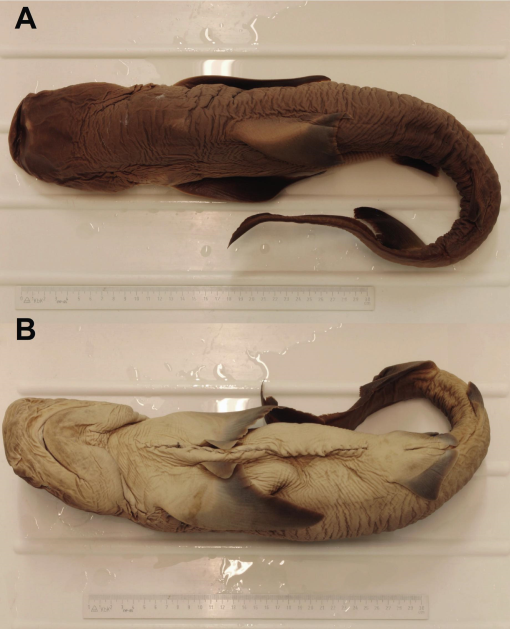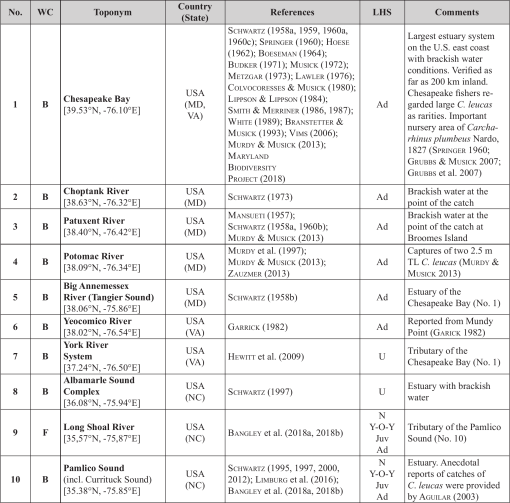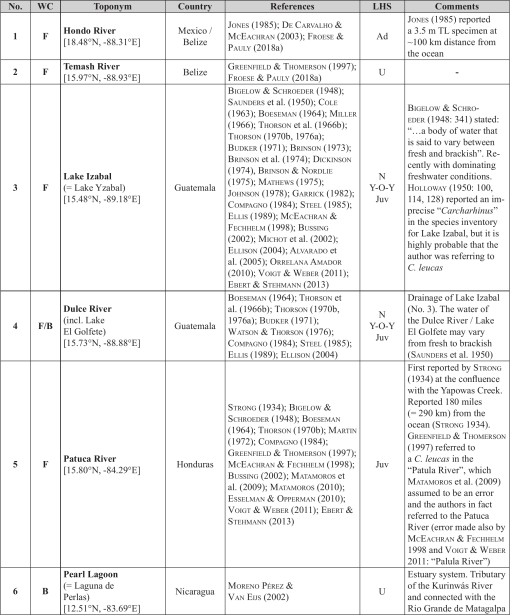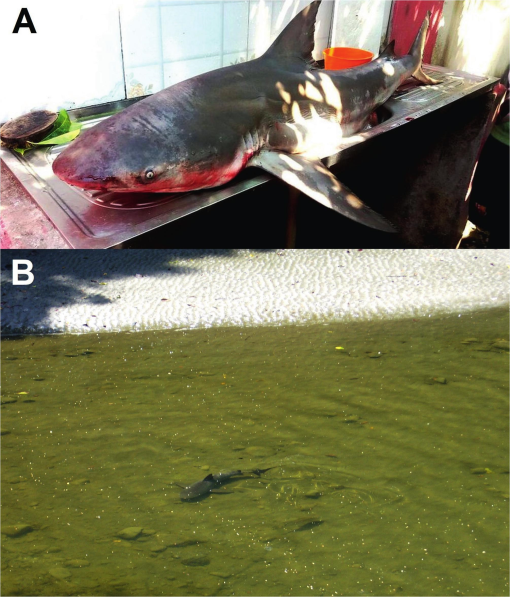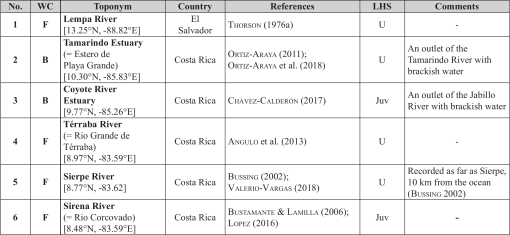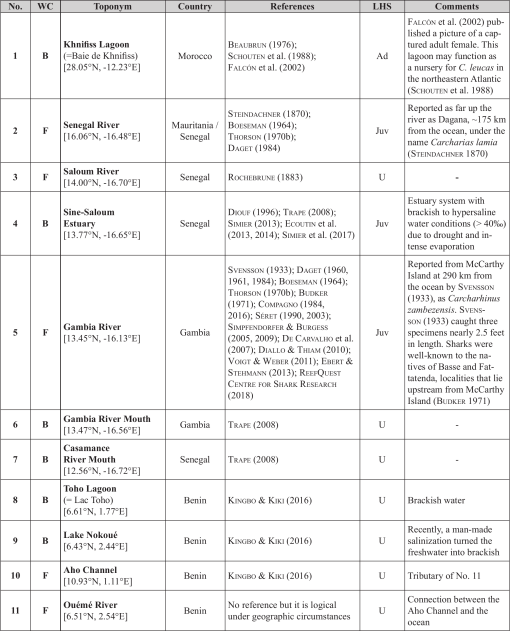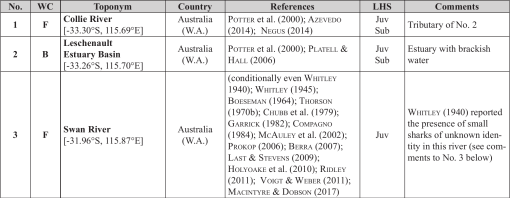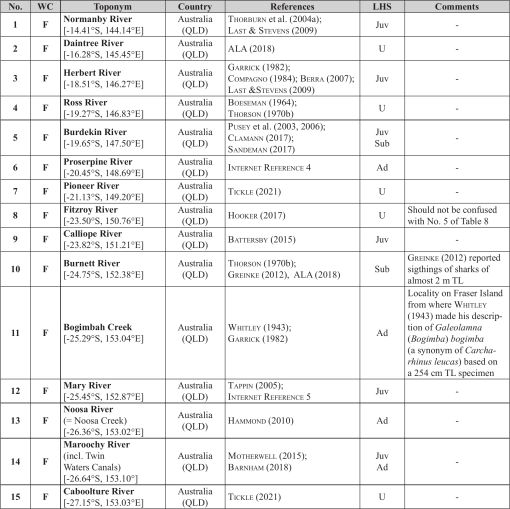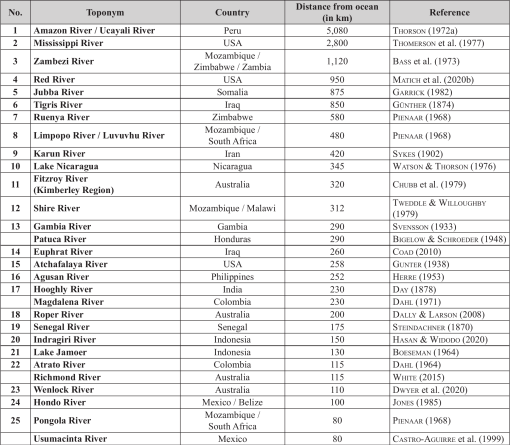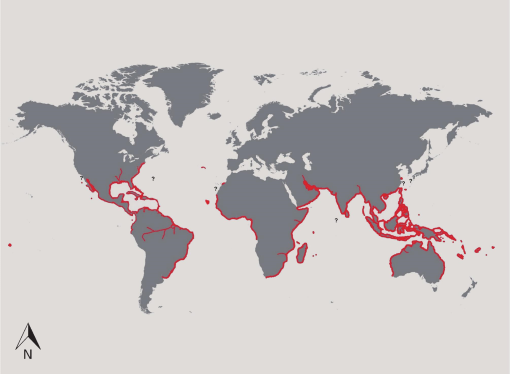Fig. 1.
Holotype of Carcharias (Prionodon) zambezensis Peters, 1852 (♂, 760 mm TL; catalog no.: ZMB 4468, Museum für Naturkunde Berlin). – A. Dorsal view. B. Ventral view. The holotype was collected by Peters (1852: 276) in the Zambezi River: “Zambeze prop Tette et Sena, 17° Lat. austr.” [Mozambique]. The exact description of the type locality was made later by Peters (1868), with the report of Carcharias (Prionodon) zambezensis from Tete and Sena along the Zambezi River (Paepke & Schmidt 1988). More than a century later, this specimen was investigated by Garrick (1982) and revised as Carcharhinus leucas. This specimen from Mozambique was the first scientific record of the euryhaline C. leucas from a pure freshwater environment and represented the first verified report of C. leucas from inland waters worldwide, just 13 years after the species was described by VALENCIENNES in Müller & Henle, 1841. Photos © Museum für Naturkunde Berlin
Table 1.
Occurrences of Carcharhinus leucas in North American rivers, lakes, estuaries, and lagoons: Atlantic Ocean coast including Gulf of Mexico. Abbreviations: WC = water conditions, F = freshwater, B = brackish water up to hypersaline conditions, F/B = salinity gradient from fresh to brackish, LHS = life history stage, Ad = adult, Sub = subadult, Juv = juvenile, Y-O-Y = young-of-the-year, N = neonate, U = unknown. Abbreviations of U.S. States: AL = Alabama; AR = Arkansas; FL = Florida; GA = Georgia; IL = Illinois; LA = Louisiana; MD = Maryland; MO = Missouri; MS = Mississippi; NC = North Carolina; OK = Oklahoma; SC = South Carolina; TN = Tennessee; TX = Texas; VA = Virginia.
Table 2.
Occurrences of Carcharhinus leucas in North American rivers, lakes, estuaries, and lagoons: Pacific Ocean coast. Abbreviations: WC = water conditions, F = freshwater, B = brackish water up to hypersaline conditions, F/B = salinity gradient from fresh to brackish, LHS = life history stage, Ad = adult, Sub = subadult, Juv = juvenile, Y-O-Y = young-of-the-year, N = neonate, U = unknown.
Table 3.
Occurrences of Carcharhinus leucas in South and Central American rivers, lakes, estuaries, and lagoons: Atlantic Ocean coast, including the Caribbean Sea. Abbreviations: WC = water conditions, F = freshwater, B = brackish water up to hypersaline conditions, F/B = salinity gradient from fresh to brackish, LHS = life history stage, Ad = adult, Sub = subadult, Juv = juvenile, Y-O-Y = young-of-the-year, N = neonate, U = unknown.
Fig. 2.
Carcharhinus leucas Valenciennes. – A. Subadult male specimen (∼1.5 m TL) captured on 29 November 2016 by local fishers along the Amazon River (Table 3, No. 41) at Pinduri (Santarém, Pará, Brazil) (photo © Jeso Carneiro). The record of the farthest freshwater penetration by C. leucas (5,080 km) was made in the Amazon River. Although C. leucas records in this major river system are a rarity, these occurrences document its repeated use by this species. B. Juvenile specimen (∼70 cm TL) swimming in shallow water on the banks of the Sirena River Estuary, Costa Rica. This estuary functions as a nursery ground for this species (Table 4, No. 7). © Pedro Francisco Navarro Jimenez
Table 4.
Occurrences of Carcharhinus leucas in South and Central American rivers, lakes, estuaries, and lagoons: Pacific Ocean coast. Abbreviations: WC = water conditions, F = freshwater, B = brackish water up to hypersaline conditions, F/B = salinity gradient from fresh to brackish, LHS = life history stage, Ad = adult, Sub = subadult, Juv = juvenile, Y-O-Y = young-of-the-year, N = neonate, U = unknown.
Table 5.
Occurrences of Carcharhinus leucas in African rivers, lakes, estuaries, and lagoons: Atlantic Ocean coast. Abbreviations: WC = water conditions, F = freshwater, B = brackish water up to hypersaline conditions, F/B = salinity gradient from fresh to brackish, LHS = life history stage, Ad = adult, Sub = subadult, Juv = juvenile, Y-O-Y = young-of-the-year, N = neonate, U = unknown.
Table 6.
Occurrences of Carcharhinus leucas in African rivers, lakes, estuaries, and lagoons: Indian Ocean coast, including Madagascar and Réunion Island. Abbreviations: WC = water conditions, F = freshwater, B = brackish water up to hypersaline conditions, F/B = salinity gradient from fresh to brackish, LHS = life history stage, Ad = adult, Sub = subadult, Juv = juvenile, Y-O-Y = young-of-the-year, N = neonate, U = unknown.
Table 7.
Occurrences of Carcharhinus leucas in Asian rivers, lakes, estuaries, and lagoons: Indian Ocean coast incl. Persian Gulf and Pacific Ocean coast. Abbreviations: WC = water conditions, F = freshwater, B = brackish water up to hypersaline conditions, F/B = salinity gradient from fresh to brackish, LHS = life history stage, Ad = adult, Sub = subadult, Juv = juvenile, Y-O-Y = young-of-the-year, N = neonate, U = unknown.
Table 8.
Occurrences of Carcharhinus leucas in Australian rivers, lakes, estuaries, and lagoons: Indian Ocean coast. Abbreviations: WC = water conditions, F = freshwater, B = brackish water up to hypersaline conditions, F/B = salinity gradient from fresh to brackish, LHS = life history stage, Ad = adult, Sub = subadult, Juv = juvenile, Y-O-Y = young-of-the-year, N = neonate, U = unknown. Abbrevations of Australian Territories: N.T. = Northern Territory; QLD = Queensland; W.A. = Western Australia.
Table 9.
Occurrences of Carcharhinus leucas in Australian rivers, lakes, estuaries, and lagoons: Pacific Ocean coast. Abbreviations: WC = water conditions, F = freshwater, B = brackish water up to hypersaline conditions, F/B = salinity gradient from fresh to brackish, LHS = life history stage, Ad = adult, Sub = subadult, Juv = juvenile, Y-O-Y = young-of-the-year, N = neonate, U = unknown. Abbrevations of Australian Territories: NSW = New South Wales; QLD = Queensland.
Table 10.
Occurrences of Carcharhinus leucas in Melanesian Island rivers, lakes, estuaries, and lagoons: Indian Ocean coast, including the Timor Sea and Arafura Sea coasts and the South Pacific Ocean coast. Abbreviations: WC = water conditions, F = freshwater, B = brackish water up to hypersaline conditions, F/B = salinity gradient from fresh to brackish, LHS = life history stage, Ad = adult, Sub = subadult, Juv = juvenile, Y-O-Y = young-of-the-year, N = neonate, U = unknown.
Fig. 3.
Absolute numbers of fresh and brackish water localities with verified records of Carcharhinus leucas (n = 415) per continent/region, ordered from highest to lowest. Abbreviations: AOC = Atlantic Ocean coast; IOC = Indian Ocean coast; POC = Pacific Ocean coast.
Table 11.
Verified global records of Carcharhinus leucas in inland rivers and lakes, with recorded distances from the ocean ranked from greatest to smallest. Only the primary reference is provided.
Fig. 4.
Distribution map of Carcharhinus leucas based on the present literature review, showing major rivers and uncertain areas (“?”).



